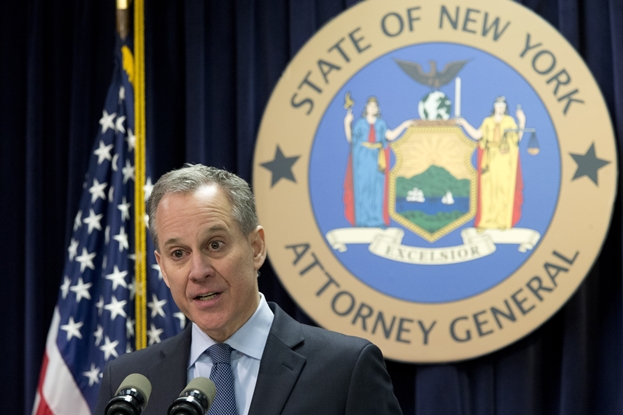It is the civil fraud trial of Maurice “Hank” Greenbergthat has been coming for 11 years, winding its way through sevenpretrial appeals and narrowing in scope as government lawyersabandoned parts of their case against the prominent insuranceexecutive.
|Former New York Attorney General Eliot Spitzer brought the casein 2005, and it began as a $6 billion lawsuit alleging ninedifferent wrongful financial acts. Shortly before ascending to thegovernor's mansion, Spitzer sued both Greenberg, who had juststepped down as American International Group Inc.'s CEO, and HowardSmith, AIG's former chief financial officer.
|Today, the lawsuit focuses on just two alleged sham transactionsand seeks disgorgement of $52 million in total from Greenberg andSmith.
|But that's not to say the bench trial before Manhattan SupremeCourt Justice Charles Ramos—which may stretch into2017 and which features David Boies of Boies, Schiller &Flexner as Greenberg's lawyer—won't be a fierce fight.
|“It only took eight years for the Second World War to be foughtand resolved. This [case] is a little longer,” David Ellenhorn, asenior trial lawyer for the state, declared in his openingstatement, according to a trial transcript. “But here we arefinally, the day of reckoning for Mr. Greenberg and Mr. Smith; theday on which the government can put forward the evidence of twofrauds.”
|Boies, for his part, countered that “Mr. Ellenhorn's openingstatement was filled with colorful accusations, assumptions andspeculations but devoid of a single piece of admissible evidencethat ties Mr. Greenberg to any improper aspect of either of the twotransactions that are still at issue.
|Courtroom drama expected
And yet the real fireworks in the trial may start Tuesday, Sept.27. That is when Greenberg, the former billionaire executive whogrew AIG into the world's largest insurance company, will take thestand to face off with lawyers from the office of New York'scurrent attorney general, Eric Schneiderman.
|Greenberg, now 91, is expected to match wits and guile againstgovernment lawyers for a day or longer. And Boies has told newsoutlets in recent weeks that Greenberg wanted to go to trial, wherehe intends to clear his name and work to preserve his legacy as oneof most prominent business titans of the last century who has alsogiven immensely to charities.
|It could make for dramatic theater in a case focused on nuancedand difficult-to-follow transactions involving reinsurance, lossesand accounting rules.
|In one of those alleged transactions, Schneiderman's officeclaims that Greenberg and Smith helped orchestrate a fraudulentreinsurance deal between AIG and General Reinsurance Corp. Thetransaction allegedly pumped up AIG's reserves by $500 million in2000 and 2001, deceiving Wall Street analysts and investors aboutthe level of losses AIG could handle.
|In the other transaction, Greenberg stands accused of playing ahands-on role in using an offshore reinsurer, which was controlledby AIG, to change underwriting losses linked to a companyauto-warranty business into capital losses. Those capital losses,the government says, were not viewed by investors to be as harmfulor important as those coming from underwriting.
|Vincent Sama, a partner at Kaye Scholer, is leading Smith'sdefense in the case.
|Continue reading…
|
New York Attorney General Eric T. Schneiderman speaks duringa news conference, Feb. 11, 2016, in New York. (Photo: AP/MaryAltaffer)
|Here are three key points to watch for as the trial kicks intogear this fall and possibly runs into the winter:
|Greenberg's testimony
Greenberg, who left AIG in 2005 when the company facedregulatory and internal investigations over its accounting, appearsto have taken the state's lawsuit against him personally. He haspublicly criticized what he views as the political nature of thesuit started by Spitzer, and Boies has argued in court papers thatSpitzer was motivated by personal animus against Greenberg because,in the mid-2000s, Greenberg loudly criticized his “prosecutorialexcesses.”
|AIG was the core of Greenberg's life for nearly four decades andhe has been fighting for the last decade to protect his reputation.“Under Mr. Greenberg's stewardship, AIG grew from a modestenterprise into the largest insurance company in history,” Boieswrote in the opening paragraph of a pretrial memorandum. “AIGemployed over 92,000 individuals, operated in 130 countries, servedapproximately 40 million customers, and had a market capitalizationof over $170 billion.”
|In the years after Spitzer has left the arena, Schneiderman hasnot backed down. In a news release this summer, Schneiderman'sspokesman said the current AG “is seeking to demonstrate that thereis one set of rules for everyone—and that no one, no matter howrich or powerful, can evade responsibility for misconduct.”
|Greenberg's ability to handle a tough examination by Ellenhorn,or one of his colleagues, may ultimately decide the day.
|The former CEO will look to disassociate himself from thewrongdoing allegedly connected to the transactions. The centraldefense for him and Smith is that the men did not work on—andcannot be shown to have ordered or worked on—the sham portions ofthe transactions outlined by the government.
|Besides potentially damaging his legacy, Greenberg, if he wereto lose the trial, may be forced to forfeit—along withSmith—millions of dollars in past bonuses plus interest. Inaddition, under injunctive relief requested by the government, heand Smith may be banned from both the securities industry and fromacting as a public company's officer or director.
|Richard Napier's deposition
A central witness for the Attorney General's Office is RichardNapier, a former senior vice president at General Reinsurance whoEllenhorn wants to use to tie Greenberg and Smith to the allegedlyfraudulent transactions.
|Near the start of the trial, the government wanted Ramos towatch some 13 hours of deposition testimony given by Napier yearsago. But Boies raised hearsay objections.
|Ramos has tabled Napier''s deposition testimony until he makesdeterminations on the hearsay argument. Whether Ramos watchesNapier—and if so, how much he views of it—along with how the judgeweighs the credibility and importance of that testimony, may bepivotal, according to Maria Patterson, a business ethics and lawprofessor at the Stern School of Business at New York Universitywho has been following the trial.
|Impact of bench trial format
Patterson said in an interview that Ramos has had the case sinceits 2005 inception. That he knows the facts and allegationsintimately will alter how the attorneys try the case, she said,adding that both sides will likely shape arguments based on hisviews of the case as expressed in previous rulings and statementsfrom the bench.
|“Nobody is going to be making grand speeches, as you might to ajury, because what's the point, this judge is presiding,” she said.“He knows the story here. … What I would do is get the witnesseson, have them testify, and not do a dog-and-pony-show trial.”
|Under state law, Greenberg and Smith are not afforded a jurytrial because the government is not asking for damages but rather aforfeit of past bonuses.
|Damages were once sought in the long-running case. But in 2013,both Greenberg and Smith were included as parties in a $115 millionsettlement in a federal class action lawsuit, brought by former AIGstockholders, that included similar allegations as those made inthis case. Under res judicata legal principles, thegovernment cannot seek damages already paid out in the classaction.
|Jason Grant is a former practicing lawyer. From 2002 to2008, he handled legal matters on behalf of AIG. He was notinvolved with and had no knowledge of the transactions underlyingthe case. He can be reached via email at [email protected] or on Twitter@JasonBarrGrant.
|Save
|Save
Want to continue reading?
Become a Free PropertyCasualty360 Digital Reader
Your access to unlimited PropertyCasualty360 content isn’t changing.
Once you are an ALM digital member, you’ll receive:
- All PropertyCasualty360.com news coverage, best practices, and in-depth analysis.
- Educational webcasts, resources from industry leaders, and informative newsletters.
- Other award-winning websites including BenefitsPRO.com and ThinkAdvisor.com.
Already have an account? Sign In
© 2024 ALM Global, LLC, All Rights Reserved. Request academic re-use from www.copyright.com. All other uses, submit a request to [email protected]. For more information visit Asset & Logo Licensing.








